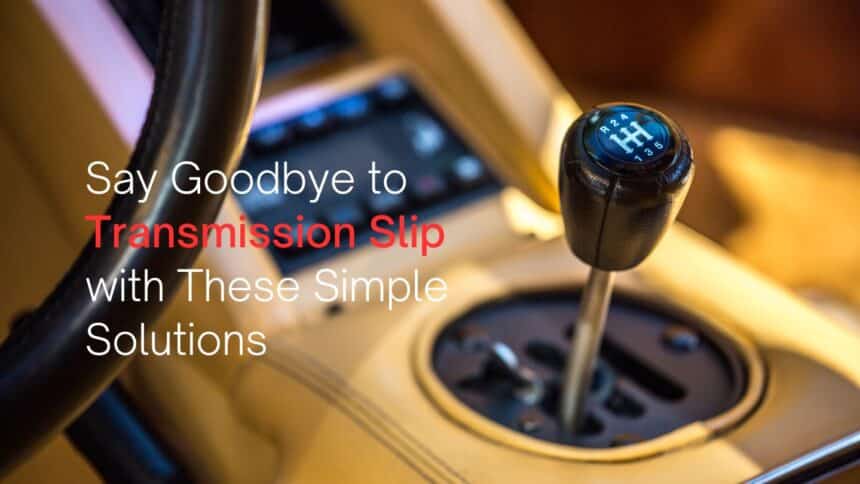Have you ever experienced a transmission slip in your car? It’s a frustrating and potentially dangerous problem that can occur when your vehicle’s transmission fails to engage properly, resulting in a loss of power or a delay in acceleration. In this comprehensive guide, we will delve into the world of transmission slip and explore its causes and possible solutions. Whether you’re a seasoned car enthusiast or a novice driver, this article will provide you with valuable insights and practical tips to help you address transmission slip car issues effectively.
What is Transmission Slip Car?
A transmission slip car refers to a vehicle that exhibits a phenomenon where the transmission fails to maintain a consistent connection between the engine and the wheels. Instead of smoothly transferring power from the engine to the wheels, the transmission slips, leading to a disruption in power delivery. This can manifest in various ways, such as a delay in acceleration, RPM fluctuations, or a complete loss of power.
Common Causes of Transmission Slip Car
Transmission slip is a frustrating problem that can disrupt the power delivery in vehicles. It occurs when the connection between the engine and the wheels fails to maintain a consistent transfer of power. In this article, we will delve into the causes of transmission slip in cars and explore the solutions to this issue.
- Inadequate Transmission Fluid
Insufficient transmission fluid is a primary cause of transmission slip. Transmission fluid plays a vital role in lubricating and cooling the transmission components. When the fluid level is too low, it can lead to overheating and inadequate lubrication, resulting in a slip. Regularly checking and maintaining the proper transmission fluid level is essential to prevent this problem. - Worn Clutch Plates
In manual transmission cars, worn clutch plates can contribute to a transmission slip. Over time, the friction material on the clutch plates wears down, reducing their ability to engage properly. This can cause slipping and difficulty in shifting gears smoothly. To address this issue, replacing the worn clutch plates with new ones is necessary. - Defective Torque Converter
The torque converter is responsible for transmitting power from the engine to the transmission. If it is faulty, it can lead to a transmission slip. Common issues with the torque converter include worn-out needle bearings, damaged seals, or a malfunctioning clutch. Repairing or replacing the defective torque converter is crucial to resolve this problem. - Problems with Transmission Solenoids
Modern vehicles utilize transmission solenoids to regulate the flow of transmission fluid. When these solenoids become faulty or clogged with debris, they can disrupt the fluid flow, resulting in a transmission slip. Cleaning or replacing the problematic solenoids is necessary to restore the proper functioning of the transmission system. - Damaged or Worn Transmission Bands
Transmission bands are flexible metal bands that control gear engagement. Over time, they can become damaged or worn, causing them to slip or fail to engage properly. This can lead to a transmission slip. To address this issue, replacing the damaged or worn transmission bands is essential. - Malfunctioning Sensors
Modern cars rely on various sensors to monitor the performance of the transmission system. A malfunctioning sensor, such as the transmission speed sensor or the throttle position sensor, can transmit inaccurate signals to the transmission control module, ultimately resulting in a slip. Repairing or replacing the malfunctioning sensors can help resolve this problem.
Solutions to Transmission Slip Car Issues
Now that we have explored the common causes of transmission slip car problems, let’s discuss some potential solutions to help you address this issue effectively. It’s important to note that while some fixes can be performed by DIY enthusiasts, others may require professional assistance. Always consult your vehicle’s manual and consider seeking professional help when in doubt.
- Check and Refill Transmission Fluid
Start by checking the transmission fluid level and condition. Consult your vehicle’s manual for the correct procedure. If the fluid level is low, add the manufacturer-recommended fluid to the appropriate level. However, if you notice a burnt smell or discolored fluid, it may be an indication of more severe transmission issues, and it is advisable to seek professional help. - Inspect and Replace Clutch Plates
If you drive a manual transmission car and suspect worn clutch plates are causing the slip, it may be necessary to inspect and replace them. This task requires mechanical expertise, so if you’re not confident in your abilities, it’s best to leave it to a professional mechanic. - Repair or Replace the Torque Converter
A malfunctioning torque converter may need repair or replacement. Depending on the severity of the issue, this can be a complex task, often requiring specialized tools and expertise. Consult with a qualified mechanic to determine the best course of action. - Clean or Replace Transmission Solenoids
If faulty transmission solenoids are the culprit behind the slip, they may need to be cleaned or replaced. This can be done by a skilled mechanic who can diagnose the specific solenoid causing the issue and perform the necessary repairs. - Replace Damaged or Worn Transmission Bands
In cases where damaged or worn transmission bands are causing the slip, replacing the bands may be required. This is a complex repair that involves disassembling the transmission, so it’s best left to a professional mechanic. - Diagnose and Repair Malfunctioning Sensors
If a malfunctioning sensor is to blame, a diagnostic scan performed by a professional mechanic can identify the faulty component. Once the issue is pinpointed, the sensor can be repaired or replaced accordingly.
FAQs About Transmission Slip Car
- What are the signs of a transmission slip car?
Some common signs of a transmission slip car include delayed or erratic gear shifting, RPM fluctuations, a burning smell, a whining noise, or a sudden loss of power during acceleration. - Can I drive my car with a transmission slip?
Continuing to drive a car with a transmission slip can potentially cause further damage to the transmission system. It’s advisable to have the issue diagnosed and repaired as soon as possible to prevent more extensive and costly repairs down the road. - How much does it cost to fix a transmission slip car?
The cost of fixing a transmission slip car can vary depending on the underlying issue, the make and model of the vehicle, and the labor rates in your area. Simple fixes like adding transmission fluid can be relatively inexpensive, while more complex repairs like replacing the torque converter or rebuilding the transmission can be costly. - How often should I check my transmission fluid?
It’s generally recommended to check your transmission fluid level and condition at least once every month or every 1,000 miles. However, consult your vehicle’s manual for the manufacturer’s specific recommendations. - Can regular maintenance prevent transmission slip car issues?
Regular maintenance, such as transmission fluid changes and following the manufacturer’s recommended service intervals, can help prevent transmission slip car problems. Additionally, addressing any minor issues promptly can prevent them from developing into more significant and costly problems. - Should I attempt to fix the transmission slip car issue myself?
While some transmission slip car issues can be resolved by knowledgeable DIY enthusiasts, it’s important to assess your mechanical skills and the complexity of the problem. If you’re unsure, it’s best to consult with a professional mechanic who can provide expert guidance and ensure the problem is resolved correctly.
Conclusion
Dealing with a transmission slip car can be a frustrating experience, but armed with knowledge about the causes and potential solutions, you can take appropriate action to resolve the issue. Whether it’s checking and refilling transmission fluid, inspecting and replacing worn clutch plates, or diagnosing and repairing faulty components, addressing the problem promptly can save you from further complications and expenses. Remember, when in doubt, consult with a qualified mechanic to ensure your vehicle’s transmission is in optimal condition.
In conclusion, understanding the causes of transmission slip in vehicles is crucial for effective troubleshooting. Inadequate transmission fluid, worn clutch plates, defective torque converters, problems with transmission solenoids, damaged or worn transmission bands, and malfunctioning sensors are some of the common culprits behind this issue. By identifying and addressing these causes, vehicle owners can restore the smooth and consistent power transfer in their cars, ensuring optimal performance on the road. Regular maintenance and timely repairs are key to preventing transmission slip and maximizing the lifespan of the transmission system.







